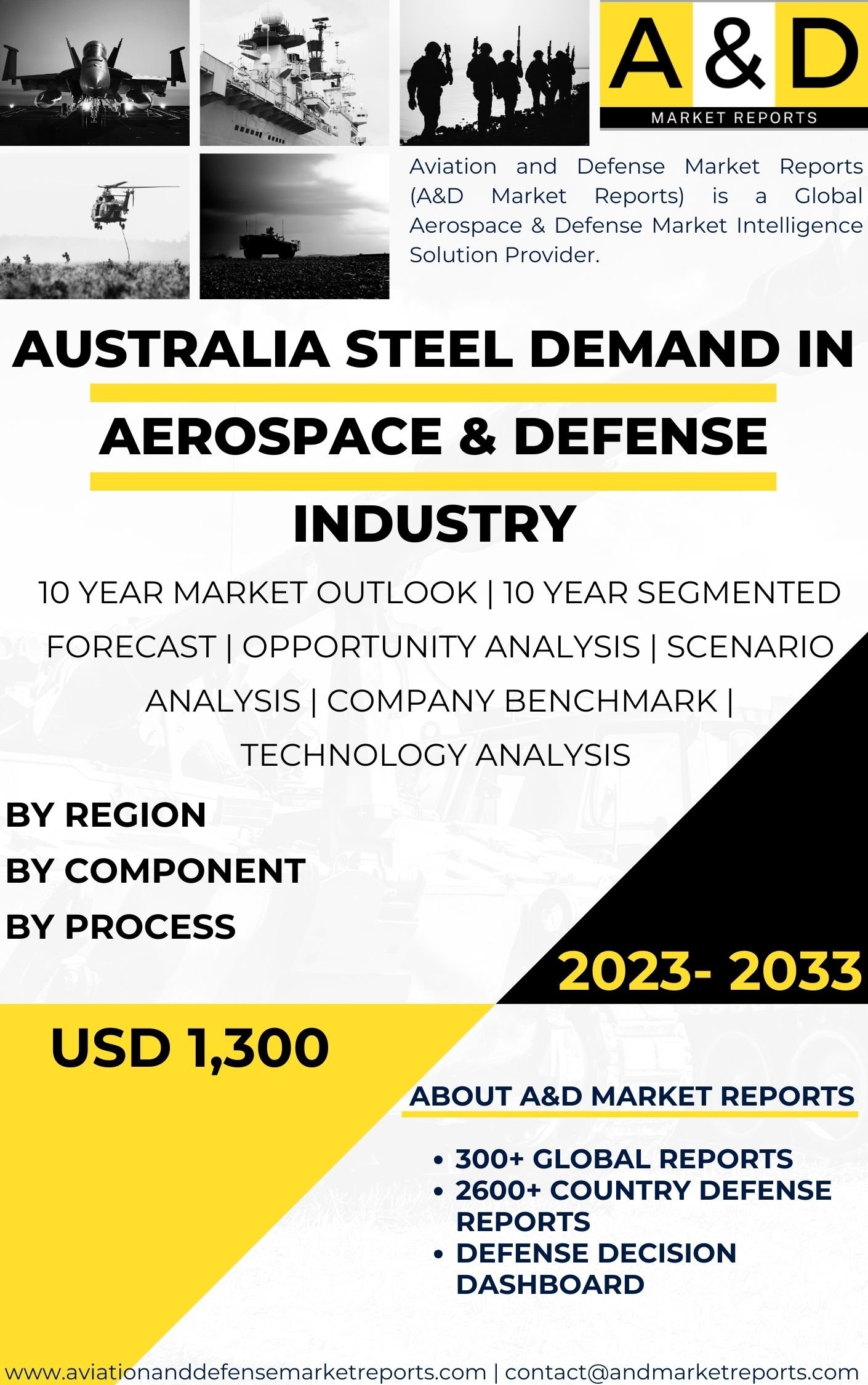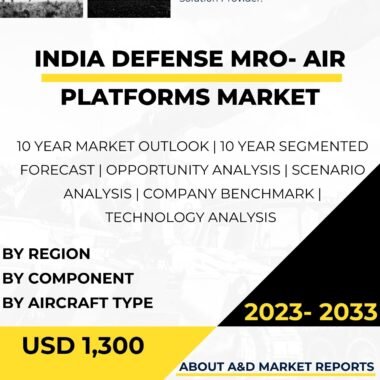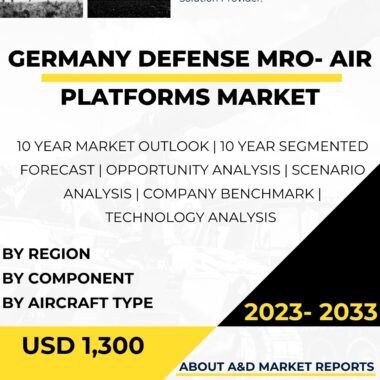Description
The demand for steel in the Australia Global Aerospace and Defense Industry is an integral and enduring aspect of the country’s national security and aviation infrastructure. Steel, renowned for its strength, durability, and versatility, serves as the backbone of aerospace and defense manufacturing, ensuring the reliability and safety of critical components and structures in military and civil aircraft.
In the military domain, steel is fundamental to the construction of a wide array of defense equipment, including armored vehicles, naval vessels, and artillery. Its exceptional strength-to-weight ratio, coupled with its resilience in extreme conditions, makes steel indispensable for military applications. The Australian Defence Force (ADF) relies on steel to enhance the protective capabilities of armored vehicles, enabling them to withstand threats in combat zones and safeguarding military personnel.
Furthermore, steel plays a crucial role in the fabrication of naval vessels, including submarines and surface ships. These vessels require robust and corrosion-resistant steel alloys to withstand the harsh marine environment. Australia’s extensive coastline and strategic maritime interests underscore the importance of high-quality steel in naval construction, ensuring the longevity and operational readiness of the country’s naval fleet.
In the aerospace sector, steel is used for various critical components, such as landing gear, structural frames, and engine parts. The aerospace industry demands steel alloys that offer exceptional strength and fatigue resistance to ensure the safety and performance of aircraft. Australia’s civil aviation sector benefits from steel’s reliability and durability, ensuring the structural integrity of commercial airliners and other aircraft.
The growth of steel demand in the Aerospace and Defense Industry is further propelled by Australia’s participation in international defense collaborations and the global supply chain. The nation’s involvement in joint defense programs and manufacturing partnerships with allied nations drives the demand for high-quality steel products to meet stringent safety and quality standards. This fosters international relationships, enhances the country’s defense capabilities, and supports the local steel industry’s growth.
In conclusion, the Australia Global Steel Demand in the Aerospace and Defense Industry is pivotal in fortifying the nation’s security and advancing its aviation capabilities. Steel’s unparalleled strength and versatility make it an essential material for military vehicles, naval vessels, and aircraft in both the defense and civilian sectors. As Australia continues to navigate evolving defense challenges and technological advancements, the demand for steel remains robust, underpinning the nation’s commitment to national security and aerospace excellence.
Table of content
Table Of Contents
1 Market Introduction
1.1 Market Introduction
1.2 Market Definition
1.3 Market Segmentation
1.4 10 Year Market Outlook
2 Market Technologies
3 Global Market Forecast
3.1 Global Market Forecast
3.2 By Component
3.3 By Process
4 APAC Market Trends & Forecast
4.1 Drivers, Restraints And Challenges
4.2 PEST
4.3 Market Forecast
4.3.1 Market Forecast By Component
4.3.2 Market Forecast By Process
4.4 Scenario Analysis
4.5 Key Companies& Profiling
5 Australia Analysis
5.1 Current Levels Of Technology Maturation In This Market
5.2 Market Forecast
5.2.1 Market Forecast By Component
5.2.2 Market Forecast By Process
5.3 Scenario Analysis
5.4 Country Defense Budget (Historical and 10- year forecast)
5.5 Defense Budget Category Spending- 10- year forecast
5.6 Procurement Analysis
5.7 EXIM Data
5.8 Patents
6 Opportunity Matrix
6.1 By Component
6.2 By Process
7 Scenario Analysis
7.1 Scenario 1
7.1.1 By Component(Scenario-1)
7.1.2 By Process(Scenario-1)
7.2 Scenario 2
7.2.1 By Component(Scenario-2)
7.2.2 By Process(Scenario-2)
8 Company Benchmark
9 Strategic Conclusions
10 About Aviation And Defense Market Reports
Segments
By Component
By Process
List of Tables
Table1: Global Market Forecast, Steel demand in Aerospace & Defense Industry
Table2: APAC Market Forecast, Steel demand in Aerospace & Defense Industry
Table3: APAC Market Forecast, By Component
Table4: APAC Market Forecast, By Process
Table5: APAC, Scenario Analysis
Table6: Australia Market Forecast, Steel demand in Aerospace & Defense Industry
Table7: Australia Market Forecast, By Component
Table8: Australia Market Forecast, By Process
Table9: Australia, Scenario Analysis
Table 10: Australia Defense Budget 10 Year Forecast
Table 11: Australia, Defense Budget Category Spending- 10- year forecast
Table 12: Australia, Procurement Analysis
Table 13: Australia, EXIM Data Analysis
Table 14: Australia, Opportunity Analysis, By Component
Table 15: Australia, Opportunity Analysis, By Process
Table 16: Australia, Scenario Analysis, By Component
Table 17: Australia, Scenario Analysis, By Process
Figure 1: Market Segmentation, Australia Steel demand in Aerospace & Defense Industry
Figure 2: Key Technology Analysis, Steel demand in Aerospace & Defense Industry
Figure 3: Global Market Forecast, Steel demand in Aerospace & Defense Industry
Figure 4: APAC, Market Forecast, Steel demand in Aerospace & Defense Industry
Figure 5: APAC, Market Forecast, By Component
Figure 6: APAC, Market Forecast, By Process
Figure 7: APAC, Scenario Analysis
Figure 8: Australia, Market Forecast, Steel demand in Aerospace & Defense Industry
Figure 9: Australia, Market Forecast, By Component
Figure 10: Australia, Market Forecast, By Process
Figure 11: Australia, Scenario Analysis
Figure 12: Australia, Defense Budget 10 Year Forecast
Figure 13: Australia, Defense Budget Category Spending- 10- year forecast
Figure 14: Australia, Procurement Analysis
Figure 15: Australia, EXIM Data Analysis
Figure 16: Australia, Opportunity Analysis, By Component
Figure 17: Australia, Opportunity Analysis, By Process
Figure 18: Australia, Scenario Analysis, By Component
Figure 19: Australia, Scenario Analysis, By Process
Figure 20: Company Benchmark




